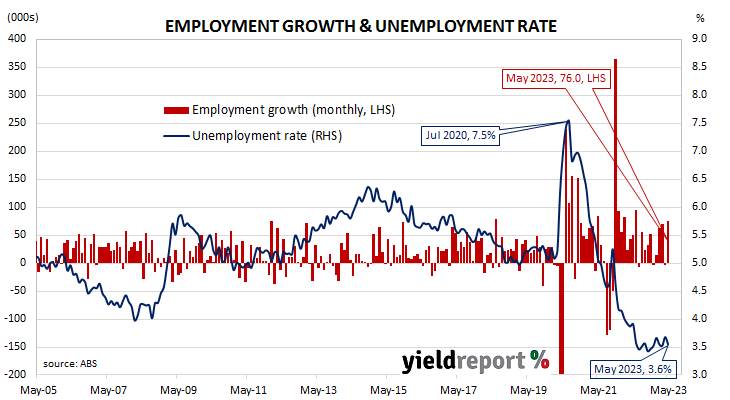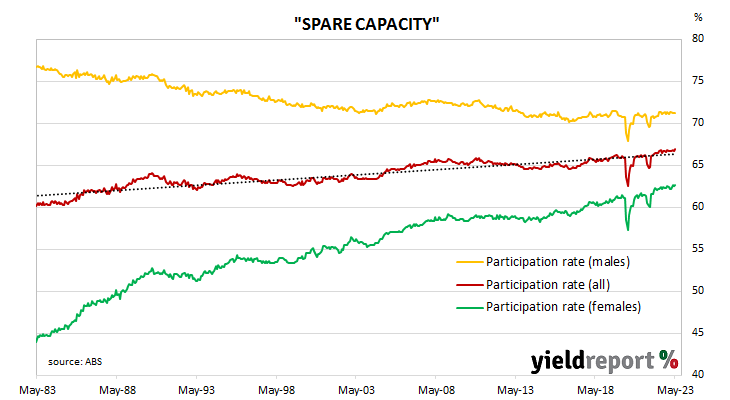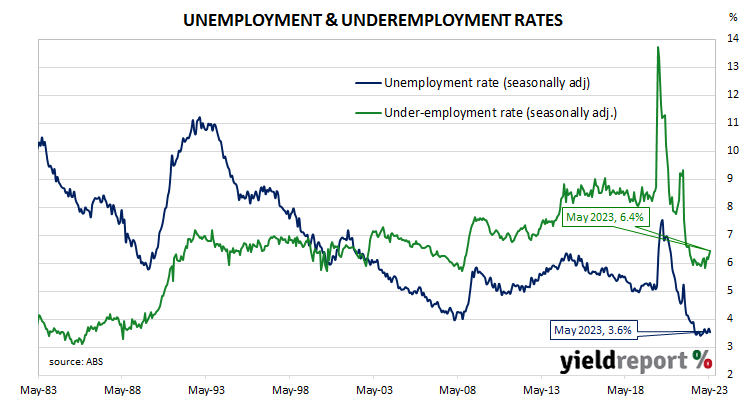Summary: Employment up 76,000 in May, more than expected; ANZ: robustness of labour data to date “undeniable”, suggests some ongoing momentum in economy; MSA: trend still a gradually softening one, consistent with forward indicators; participation rate rises to 66.9%; jobless rate falls to 3.6%; more part-time, full-time jobs; aggregate work hours down 1.8%; MSA: hours worked increase has “interesting implications” for RBA’s productivity focus; underemployment rate ticks rises to 6.4%.
Australia’s period of falling unemployment came to an end in early 2019 when the jobless rate hit a low of 4.9%. It then averaged around 5.2% through to March 2020, bouncing around in a range from 5.1% to 5.3%. Leading indicators such as ANZ-Indeed’s Job Ads survey and NAB’s capacity utilisation estimate suggested the unemployment rate would rise in the June 2020 quarter and it did so, sharply. The jobless rate peaked in July 2020 but fell below 7% a month later and then trended lower through 2021 and 2022.
The latest Labour force figures have now been released and they indicate the number of people employed in Australia according to ABS definitions increased by 76,000 in May. The result was noticeably more than the 15,000 increase which had been generally expected and it contrasted with April’s 4,000 decline after revisions.
“While the weakness in Q1 GDP suggests the pace of jobs growth should moderate, and by a lot over coming months, the general robustness of the labour force survey over 2023 to date is undeniable and suggests some ongoing momentum in the economy,” said ANZ Head of Australian Economics Adam Boyton.
Domestic Treasury bond yields mostly decreased modestly on the day. By the close of business, the 3-year ACGB yield had returned to its starting point at 3.92%, the 10-year yield had lost 2bps to 3.96% while the 20-year yield finished 1bp lower at 4.26%.
In the cash futures market, expectations regarding further rate rises in 2023 firmed. At the end of the day, contracts implied the cash rate would rise from the current rate of 4.07% to average 4.21% in July and then to 4.385% in August. February 2024 contracts implied a 4.575% average cash rate while May 2024 contracts implied 4.46%, 39bps more than the current rate.
“The trend still looks to be a gradually softening one, consistent with forward indicators,” said Morgan Stanley Australia economist Chris Read. “It keeps the RBA on a tightening bias, with rate hikes in July and August in our view.”
The participation rate rose from March’s figure of 66.7% to 66.9% as the total available workforce increased by 59,500 to 14.528 million while the number of unemployed persons decreased by 16,500 to 515,900. As a result, the unemployment rate fell back from 3.7% to 3.6%.
The aggregate number of hours worked across the Australian economy decreased by 1.8% even as 14,300 residents gained part-time positions and 61,700 residents gained full-time positions. On a 12-month basis and after revisions, aggregate hours worked increased by 4.8% as 80,300 more people held part-time positions and 385,300 more people held full-time positions than in May 2022.
More attention has been paid to the underemployment rate in recent years, which is the number of people in work but who wish to work more hours than they do currently. May’s underemployment rate increased from 6.2% to 6.4%, 0.6 percentage points above this cycle’s low.
The underutilisation rate, that is the sum of the underemployment rate and the unemployment rate, has a strong correlation with the annual growth rate of the ABS private sector wage index when advanced by two quarters. May’s underutilisation rate of 10.0% corresponds with an annual growth rate of about 4.2%.




